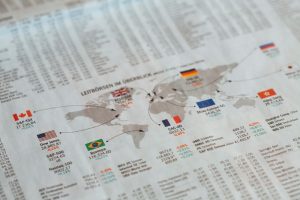Investing Guru: Why Not to Cash Out Before a Crash
Discover why holding steady during market turbulence can be wiser than cashing out. Learn from the experts and safeguard your financial futu
Importance of Long-Term Investing Strategy
Weathering Market Volatility
One of the core tenets of a long-term investing strategy is its ability to help investors weather market volatility. Short-term market fluctuations can be unsettling, especially when headlines predict an imminent crash.
However, history has shown that markets tend to recover over time, often reaching new highs. By maintaining a long-term perspective, investors can avoid the pitfalls of panic selling and instead focus on the potential for future growth.
Compounding Returns
Long-term investing allows for the power of compounding to work in an investor’s favor.
Compounding is the process where the returns on an investment generate their own returns over time. The longer an investment is held, the more pronounced the effects of compounding become.
This can significantly enhance the overall return on investment, making it a compelling reason to adopt a long-term strategy.
Reducing Emotional Decision-Making
Investing with a long-term outlook can help reduce the emotional decision-making that often accompanies short-term market movements. When investors focus on long-term goals, they are less likely to make impulsive decisions based on fear or greed.
This disciplined approach can lead to more rational decision-making, aligning investment choices with long-term objectives rather than short-lived market trends.
Tax Efficiency
Holding investments for the long term can also offer tax advantages. In many jurisdictions, long-term capital gains are taxed at a lower rate than short-term gains.
By minimizing the frequency of buying and selling, investors can not only reduce transaction costs but also benefit from more favorable tax treatment, thereby enhancing their net returns.
Aligning with Personal Goals
A long-term investing strategy aligns well with personal financial goals, such as retirement planning or funding a child’s education. These goals typically have a time horizon of several years or even decades.
By investing with a long-term perspective, individuals can better match their investment strategy to their personal timelines, ensuring that they are on track to meet their future financial needs.
Risks of Market Timing
Unpredictability of Market Movements
One of the primary risks associated with market timing is the inherent unpredictability of market movements. Even seasoned investors and financial analysts find it challenging to forecast short-term market fluctuations accurately.
The stock market is influenced by a myriad of factors, including economic indicators, geopolitical events, and investor sentiment, all of which can change rapidly and unexpectedly. Attempting to time the market often leads to missed opportunities and potential losses.
Missing Out on Long-Term Gains
Investors who attempt to time the market risk missing out on long-term gains.
Historical data shows that the stock market tends to increase in value over time, despite short-term volatility. By cashing out investments in anticipation of a market crash, investors may miss periods of significant growth that often follow downturns.
Staying invested allows individuals to benefit from the market’s overall upward trajectory, leveraging the power of compound interest.
Emotional Decision-Making
Market timing can lead to emotional decision-making, which is often detrimental to investment success. The fear of losses during a market downturn can drive investors to sell their holdings prematurely, while the greed of potential gains can lead to buying at market peaks.
Such emotionally-driven decisions can result in buying high and selling low, a pattern that erodes investment returns over time. Maintaining a disciplined, long-term investment strategy helps mitigate the impact of emotional biases.
Increased Transaction Costs
Frequent buying and selling of securities to time the market can lead to increased transaction costs.
These costs include brokerage fees, taxes, and other expenses associated with trading. Over time, these costs can significantly reduce the overall returns on an investment portfolio.
By adopting a buy-and-hold strategy, investors can minimize these expenses and enhance their long-term financial outcomes.
Opportunity Cost
Attempting to time the market also involves opportunity costs. When investors hold cash in anticipation of a market downturn, they forego potential returns that could have been earned if the market continued to rise.
This lost opportunity can be particularly costly during bull markets, where substantial gains are possible. By remaining invested, individuals can ensure their capital is working for them, rather than sitting idle.
Benefits of Riding Out Market Volatility
Long-Term Growth Potential
Market volatility can be unsettling, but it is important to remember that historically, markets have shown a tendency to recover and grow over the long term.
By staying invested, you allow your portfolio to benefit from the compounding returns that come with market rebounds. Pulling out of the market during downturns can result in missing out on significant gains when the market recovers.
Avoiding Emotional Decision-Making
One of the greatest risks during periods of market volatility is making decisions based on fear or panic.
By committing to ride out the volatility, investors can avoid the pitfalls of emotional decision-making. This disciplined approach helps in maintaining a focus on long-term investment goals, rather than reacting to short-term market fluctuations.
Opportunity to Buy Low
Volatile markets often present opportunities to purchase quality investments at lower prices.
By staying in the market, investors can take advantage of these opportunities to buy low, which can enhance future returns. This strategy aligns with the age-old investment principle of buying low and selling high.
Rebalancing and Diversification Benefits
Market volatility can also serve as a reminder to review and rebalance your portfolio.
This process ensures that your investment strategy remains aligned with your risk tolerance and financial goals. Additionally, maintaining a diversified portfolio can help mitigate risks associated with market fluctuations, as different asset classes may react differently to market conditions.
Tax Advantages
Staying invested during volatile times can also offer tax benefits.
For instance, selling investments during a downturn can trigger capital gains taxes, which can erode your overall returns. By holding onto your investments, you can defer these taxes and potentially benefit from lower tax rates on long-term capital gains.
Expert Tips for Weathering Market Crashes
Stay Invested for the Long Term
One of the most crucial pieces of advice from investing gurus is to remain invested, even when a market crash seems imminent.
Historically, markets have shown resilience and the ability to recover over time. By staying invested, you allow your portfolio to benefit from the eventual rebound and growth that typically follows a downturn.
Exiting the market in anticipation of a crash can lead to missed opportunities.
Timing the market is notoriously difficult, even for seasoned investors. Instead of trying to predict the exact moment of a crash, focus on maintaining a diversified portfolio that can withstand volatility.
Focus on Diversification
Diversification is a key strategy for mitigating risk during market crashes.
By spreading investments across various asset classes, sectors, and geographies, you reduce the impact of any single investment’s poor performance on your overall portfolio. This approach helps cushion the blow during downturns and positions your portfolio for recovery.
Consider including a mix of stocks, bonds, and alternative investments to achieve a balanced portfolio.
Diversification not only provides stability but also offers the potential for growth in different market conditions.
Reassess Your Risk Tolerance
Market crashes can serve as a valuable opportunity to reassess your risk tolerance. If the thought of a market downturn causes significant anxiety, it may be time to adjust your investment strategy.
Aligning your portfolio with your risk tolerance ensures that you remain comfortable with your investment decisions, even during periods of volatility.
Consult with a financial advisor to evaluate your current risk profile and make any necessary adjustments. This proactive approach can help you remain calm and focused, rather than reacting impulsively to market fluctuations.
Maintain a Cash Reserve
Having a cash reserve is a prudent strategy for weathering market crashes.
This reserve acts as a financial cushion, allowing you to cover expenses without having to liquidate investments at a loss during a downturn. A cash reserve provides peace of mind and financial flexibility, enabling you to make strategic decisions rather than reactive ones.
Experts recommend keeping three to six months’ worth of living expenses in easily accessible cash or cash equivalents.
This buffer can help you navigate short-term disruptions while keeping your long-term investment strategy intact.
FAQ
Q1: Why shouldn’t I cash out my investments if I anticipate a market crash?
A1: Cashing out your investments in anticipation of a market crash can lead to missing out on potential recovery gains. Markets are unpredictable, and timing them perfectly is nearly impossible. Historically, markets have rebounded after downturns, and staying invested allows you to benefit from the eventual recovery and long-term growth.
Q2: What are the risks of trying to time the market by cashing out before a crash?
A2: The primary risk of trying to time the market is missing out on significant gains. If you sell your investments and the market doesn’t crash as expected, you may lose out on potential appreciation. Additionally, re-entering the market at the right time can be challenging, often resulting in buying back at higher prices, which can negatively impact your overall returns.
Q3: How can I protect my investments if I’m worried about a market downturn?
A3: Instead of cashing out, consider diversifying your portfolio to spread risk across different asset classes. You might also explore defensive investments, such as bonds or dividend-paying stocks, which tend to be more stable during downturns. Regularly reviewing and rebalancing your portfolio can also help ensure it aligns with your risk tolerance and financial goals, providing some protection against market volatility.
Takeaway
“Maximize your trading potential now! Download our premium chart analysis guide for expert insights. Sign up for early access to exclusive market insights and stay ahead of the curve. Follow real-time trade alerts for immediate action. Seize opportunities, drive ROI, and conquer the markets today!” Industry analysts believe this signals a shift in market dynamics.











Comments